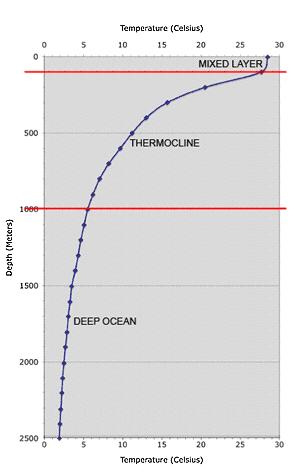As you saw in the last blog, two of the SCUBAnauts — Collin and Anna — descended in submersibles to about 400 m beneath the ocean surface to explore the seas of Hawaii. What kind of environment did they likely encounter?
If you go to the FLEXEforum Web page, you will find a plot that shows how the temperature varies with depth at a tropical site (9° N latitude) which should not differ too much from the Hawaiian region (20° N, 157° W).
The temperature inside the submersibles reached 15-16° C when they were 400 m below the surface. How cold was it in the water outside? If the graph applies (it should be close), the temperature outside was a bit cooler – more like 12-13° Celsius. If they could go down farther, they would have reached even cooler temperatures.
Why does the ocean get cooler farther down?
In the ocean, the wind stirs up the water. This results in a “mixed layer,” which is about 100 m deep in the figure. If we magnified the upper part of the figure, you would find that the temperature very near the surface can change with depth. When the wind is calm, the sun will heat up just the upper part of the ocean, and it can get quite warm. Flying over the ocean on a calm day, you can find pools of warm water — 30° C and higher in the tropics. Sometimes this water is recently fallen rain, which is less salty and hence less dense than ocean water, and thus won’t mix down as well as salty water when the wind blows. The instrument used — an infrared thermometer — is much like the one used in the GLOBE surface temperature protocols.
But this is only part of the story. From the Web site above, click your mouse to see ocean temperature profiles in other parts of the world. In the high latitudes, the surface water temperatures are much cooler, about 3° Celsius in the figure. This cold water, being dense (water is densest at 4° Celsius), can sink and spread out near the bottom of the ocean, beneath the warmer waters at lower latitudes.
Thinking about the SCUBAnauts, explore the FLEXE Web site further. There is even a link on the right hand side to try your hand at piloting a submersible (Alvin). And you can now follow the FLEXE Research Cruise and read a Teacher’s Blog from the FLEXE cruise where she and scientists are studying temperature variation in the extreme deep-sea environment, and looking to see how the vent ecosystem has changed since a major seafloor eruption two years ago! You can access all of these links from the GLOBE FLEXE page. Check back often for updates and during the week of December 17th and a link to a Phone Call from the Extreme between the research cruise and the GLOBE Program office.

Temperature as a function of depth, measured at 9 Degrees North. For further information about this plot and what is means, visit the FLEXEforum Web page.
